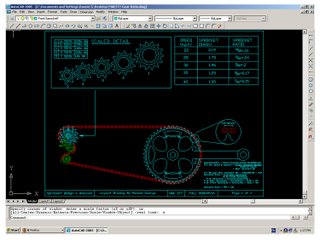


Boy, talk about a busy week! Classes and homeworks pile up on top of me like a bunch of elephants and its overwhleming! Ok, ignore my silly whining and get on with this post.
Anyway, so I was working on my first CAD design this semester, something called Sprocket Analysis. We had to design this five speed drivetrain. Remember, I mentioned this is my old post. So I learnt quite a little about what I forgot since the last time I touched AutoCAD (that was 2 years ago).
Maybe its just me, but I dont like Autocad too much. First impression is last impression. The interface could improve. Some things just take a lot of time to do. Its an extensive software! I'm sure its easy to get frustrated.
Anyway, here's what my homework looks like. The front sprocket looks a bit weird, I know...but hey, whats something without a new concept? Its just art, not engineering! I had very limited time to work on this, so I didn't pay too much attention to details there.
If you want to learn how bicycle gear works, this is a good place to start, but I'm assuming you have some knowledge about gear ratios. We were all assigned a 5-speed bike, which means 5 sprockets at the rear with 5 different speeds possible.
For a constant pedal revolution, as the chain jumps onto different sized sprockets, the speed proportionately jumps or falls according to the sprocket ratio.
In my case, Sprocket Ratio = Rear Sprocket/Front Sprocket. A sprocket, again, is a tooth on a wheel used to drive a chain.
I've provided magnified pictures for my calculations for one speed, like 20m.p.h. You can do the same for other speeds, and come out with the required rear sprocket diameter. Its basically a whole lot of number crunching, nothing too rocket-science like.
Just remember, it all starts from your Base Speed calculation, which is the speed for a 1:1 rear to front sprocket ratio. You can then extend this to a modern 9 speed or 10 speed bike to get the best out of your machine!! Have fun!!
P.S : Pictures are done in photoshop with a resolution of 300ppi.
Saturday, September 16, 2006
1 Sprocket Ratio Design and Analysis
* * *
Labels:
Design Analysis
Pollinated by
Ron George
Subscribe to:
Post Comments (Atom)



Thanks Ron, that was really helpful. Eventhough I dont know much abt the program being a beginner.. the figure seemed self explanatory and as I read through ,things made more sense. Thanks buddy! Keep up the good work!
ReplyDelete